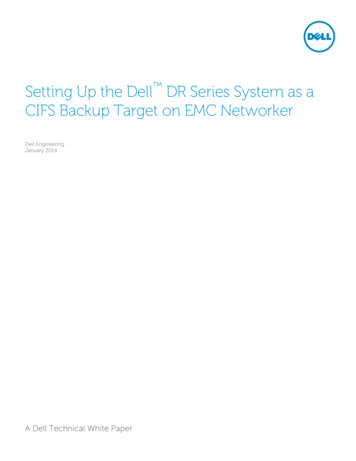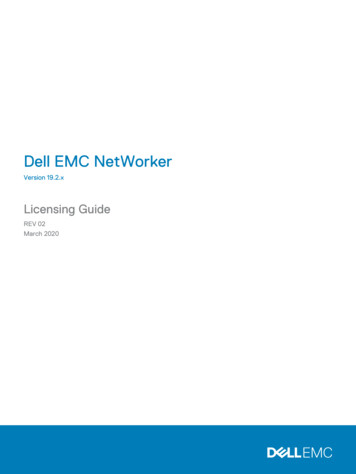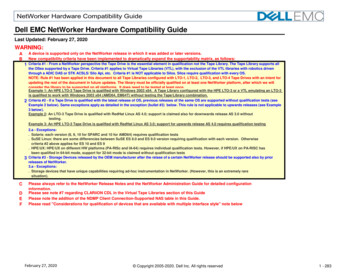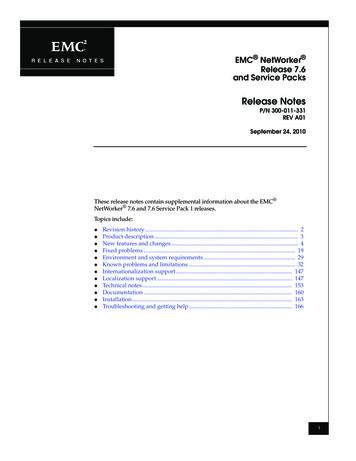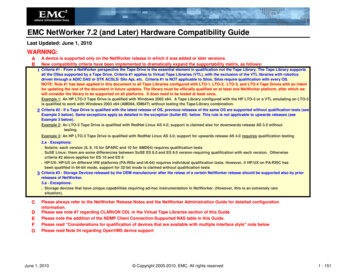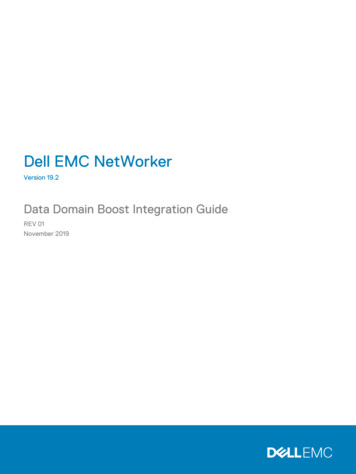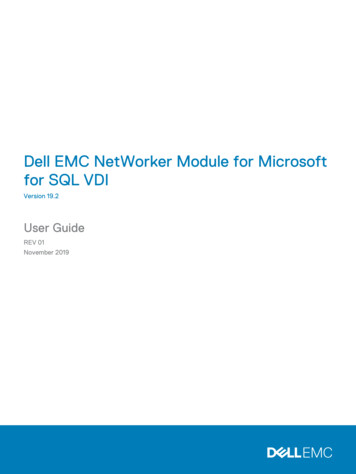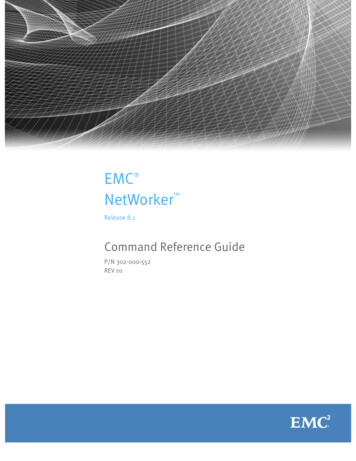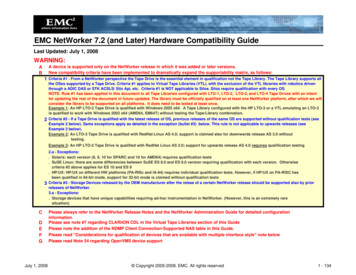
Transcription
EMC NetWorker Licensing GuideP/N 300-011-196REV A03EMC CorporationCorporate Headquarters:Hopkinton, MA 01748-91031-508-435-1000www.EMC.com
Copyright 2011 EMC Corporation. All rights reserved.Published August 2011EMC believes the information in this publication is accurate as of its publication date. The information is subject to changewithout notice.THE INFORMATION IN THIS PUBLICATION IS PROVIDED “AS IS.” EMC CORPORATION MAKES NOREPRESENTATIONS OR WARRANTIES OF ANY KIND WITH RESPECT TO THE INFORMATION IN THIS PUBLICATION,AND SPECIFICALLY DISCLAIMS IMPLIED WARRANTIES OF MERCHANTABILITY OR FITNESS FOR A PARTICULARPURPOSE.Use, copying, and distribution of any EMC software described in this publication requires an applicable software license.For the most up-to-date regulatory document for your product line, go to the Technical Documentation and Advisories sectionon EMC Powerlink.For the most up-to-date listing of EMC product names, see EMC Corporation Trademarks on EMC.com.All other trademarks used herein are the property of their respective owners.2EMC NetWorker Licensing Guide
PrefaceAs part of an effort to improve and enhance the performance and capabilities of its productlines, EMC periodically releases revisions of its software. Therefore, some functions describedin this document may not be supported by all versions of the software or hardware currentlyin use. For the most up-to-date information on product features, refer to your product releasenotes.If a product does not function properly or does not function as described in this document,please contact your EMC representative.AudienceThis guide is intended for use by system administrators who are responsible forinstalling and licensing NetWorker software.Readers of this document are expected to be familiar with the following topics: Installing NetWorker software NetWorker software requirements and configurationThe information in this guide assumes that the EMC NetWorker software is installedand that all of the software and hardware requirements have been met on thecomputer that accesses the NetWorker Management Console interface (known asConsole). These requirements are described in the NetWorker Installation Guide.You can use either the traditional licensing model or the source capacity licensingmodel to permanently license the NetWorker software. Capacity licensing is a newlicensing option and is offered as an alternative to the traditional licensing model.You can choose either the traditional or capacity licensing, but can use only onemethod per NetWorker server or datazone.RelateddocumentationRelated documents and tools include: EMC NetWorker Release Notes for your current release EMC NetWorker Installation Guide for your current release EMC NetWorker Administration Guide for your current release, for informationabout using your current NetWorker release and its Management Console(Console). EMC NetWorker License Manager Installation and Administration Guide EMC Powerlink online user documentation, such as: The Powerlink License Management page The Powerlink Licensing portal: Powerlink Frequently Asked QuestionsEMC NetWorker Licensing Guide3
PrefaceConventions used in this documentEMC uses the following conventions for special notices.Note: A note presents information that is important, but not hazard-related.CAUTIONA caution contains information essential to avoid data loss or damage to the systemor equipment.IMPORTANTAn important notice contains information essential to operation of the software.Typographical conventionsEMC uses the following type style conventions in this document:NormalUsed in running (nonprocedural) text for: Names of interface elements (such as names of windows, dialog boxes, buttons,fields, and menus) Names of resources, attributes, pools, Boolean expressions, buttons, DQLstatements, keywords, clauses, environment variables, filenames, functions,utilities URLs, pathnames, filenames, directory names, computer names, links, groups,service keys, file systems, notificationsBold:Used in running (nonprocedural) text for: Names of commands, daemons, options, programs, processes, services,applications, utilities, kernels, notifications, system call, man pagesUsed in procedures for: Names of interface elements (such as names of windows, dialog boxes, buttons,fields, and menus) What user specifically selects, clicks, presses, or types4Italic:Used in all text (including procedures) for: Full titles of publications referenced in text Emphasis (for example a new term) VariablesCourier:Used for: System output, such as an error message or script URLs, complete paths, filenames, prompts, and syntax when shown outside ofrunning text.Courier bold:Used for: Specific user input (such as commands)Courier italic:Used in procedures for: Variables on command line User input variables Angle brackets enclose parameter or variable values supplied by the user[]Square brackets enclose optional values Vertical bar indicates alternate selections - the bar means “or”{}Braces indicate content that you must specify (that is, x or y or z).Ellipses indicate nonessential information omitted from the exampleEMC NetWorker Licensing Guide
PrefaceWhere to get helpEMC support, product, and licensing information can be obtained as follows.Product information — For documentation, release notes, software updates, or forinformation about EMC products, licensing, and service, go to the EMC Powerlinkwebsite (registration required) at: http://Powerlink.EMC.comTechnical support — For technical support, go to EMC Customer Service onPowerlink. To open a service request through Powerlink, you must have a validsupport agreement. Please contact your EMC sales representative for details aboutobtaining a valid support agreement or to answer any questions about your account.Your commentsYour suggestions will help us continue to improve the accuracy, organization, andoverall quality of the user publications. Please send your opinion of this document to:BSGDocumentation@emc.comIf you have issues, comments, or questions about specific information or procedures,please include the title and, if available, the part number, the revision (for example,A01), the page numbers, and any other details that will help us locate the subject youare addressing.Revision historyThe following table lists the revision history of this document.RevisionDateDescription - added or changed sectionsA03August 26, 2011Updates to the capacity licensing model contentA02April 21, 2011NMM 2.3 traditional licensing model content addedA01September 24, 2010Initial publication of this documentEMC NetWorker Licensing Guide5
Preface6EMC NetWorker Licensing Guide
ContentsPrefaceChapter 1About this GuideAbout this Guide.Deciding which licensing model to use.Capacity licensing model .Traditional licensing model .Chapter 212131313NetWorker Traditional Licensing ModelCriteria for selecting a NetWorker licensing model .About the traditional licensing model.Base enabler.Evaluation enabler.Update enabler.The evaluation process.Evaluating a new installation of NetWorker software .Evaluating features of an existing NetWorker installation .Evaluation enabler.How to delete an enabler code .License process flow.How to permanently license the NetWorker software.Task 1: If required, install the NetWorker software for evaluation .Task 2: Send the purchase order.Task 3: Review the License Authorization Code letter .Task 4: Obtain the host ID of the NetWorker server .Task 5: Activate the software license certificate.Task 6: Download the NetWorker license keys .Task 7: If required, delete all evaluation enabler codes.Task 8: If required, upgrade or downgrade the base enabler .Task 9: Apply the license key on the NetWorker server .Product licenses.Using a licensing template .NetWorker license tips .Archiving licensing .Client connection licenses .Cluster licensing .DDS licensing .HomeBase server/agent licensing .NDMP licensing.NetWorker cloud licensing .EMC NetWorker Licensing 828292929303031317
ContentsNetWorker Data Domain device licensing. 31NetWorker Module licensing. 32NetWorker storage node licensing . 35Virtual environments simplified licensing. 35Virtual Tape Library licensing . 38Chapter 3NetWorker Capacity Licensing ModelCriteria for selecting a NetWorker licensing model . 40About the capacity licensing model . 40NetWorker capacity licenses . 41NetWorker capacity licensing options and modules. 41Benefits of the capacity licensing model. 42Requirements of the capacity licensing model . 42How to evaluate the NetWorker software . 42Evaluating a new installation of NetWorker software . 42How to delete an enabler code . 44License process flow . 44How to permanently license the NetWorker software . 45Task 1: If required, install the NetWorker software for evaluation. 46Task 2: Calculate the backup environment's capacity usage. 46Task 3: Send the purchase order . 46Task 4: Review the LAC letter. 47Task 5: Obtain the host ID of the NetWorker server . 47Task 6: Activate the software license certificate . 48Task 7: Download the NetWorker license key. 49Task 8: Apply the license key on the NetWorker server . 50Task 9: If required, delete enabler codes that are not relevant to capacitylicensing. 52Task 10: Verify that the capacity licenses and enablers have been properlyinstalled . 53About the AMP appliance . 53Setting up the virtual machine environment . 54Downloading and installing the AMP appliance. 54Configuring the AMP appliance for the NetWorker software. 55Using the AMP appliance to measure the capacity usage . 56Situations where the AMP appliance and actual estimates differ . 58Calculating the backup environment’s capacity usage . 58FAQ: Capacity Licensing. 59Chapter 4Troubleshooting and Best PracticesDiagnosing licensing issues . 64How to obtain NetWorker license information . 64How to avoid an interruption in backups when changing the computeror network address . 65How to query a server . 65Querying a server for all information . 65How to determine the number of available client licenses. 66How to manually type the license key on a NetWorker server or a NetWorkerLicense Manager system . 678EMC NetWorker Licensing Guide
ContentsLicense Conformance Summary.Accessing the License Conformance Summary .License Conformance Summary details.How to provide feedback .Best Practices .Using a licensing template .NetWorker license tips .Using the base enabler .Applying the auth code .Chapter 5697070717172727273NetWorker License ManagerAbout the NetWorker License Manager. 76Using an enabler code . 76Using an authorization code . 76Chapter 6Support ObsolescenceSupport Obsolescence . 78GlossaryEMC NetWorker Licensing Guide9
Contents10EMC NetWorker Licensing Guide
1About this GuideThis chapter includes the following topics: About this Guide . 12Deciding which licensing model to use . 13About this Guide11
About this GuideAbout this GuideThe information in this guide assumes that the EMC NetWorker software isinstalled and that all of the software and hardware requirements have been met onthe computer that accesses the NetWorker Management Console interface (known asConsole). These requirements are described in the NetWorker Installation Guide.You can use either the traditional licensing model or the source capacity licensingmodel to permanently license the NetWorker software. Capacity licensing is a newlicensing option and is offered as an alternative to the traditional licensing model.You can choose either the traditional or capacity licensing, but can use only onemethod per NetWorker server or datazone.About this Guide“Deciding which licensing model to use” on page 13 provides information to helpyou determine which of the two NetWorker licensing models to use: NetWorker Traditional Licensing Mode NetWorker Source Capacity Licensing ModelNetWorker Traditional Licensing ModelChapter 2, “NetWorker Traditional Licensing Model,” provides information outliningthe traditional NetWorker licensing model. This chapter outlines how to evaluate andpermanently license the NetWorker software. It also provides information on thevarious product licenses available for purchase through the traditional licensingmodel.The traditional licensing model is price effective for deploying basic backuptechnology such as regular client and tape backup.NetWorker Source Capacity Licensing ModelChapter 3, “NetWorker Capacity Licensing Model,” provides information outliningthe NetWorker source capacity licensing model. This chapter describes this newlicensing model and its benefits. It also outlines how to evaluate and permanentlylicense the NetWorker software.Troubleshooting and Best PracticesChapter 4, “Troubleshooting and Best Practices” provides NetWorker licensingtroubleshooting information.NetWorker License ManagerChapter 5, “NetWorker License Manager” provides information about the NetWorkerLicense Manager software including information outlining how to enter and deletean enabler code, enter an authorization code, and how to change a License Managerserver.Support ObsolescenceChapter 6, “Support Obsolescence,” provides information on how to acquireinformation on product support and obsolescence.12EMC NetWorker Licensing Guide
About this GuideDeciding which licensing model to useReview this section to determine which of the two NetWorker licensing models touse: “Capacity licensing model” on page 13 “Traditional licensing model” on page 13Capacity licensing modelThe capacity licensing model is price-effective for backup environments that: Contain a large number of backup clients, where the average data per client is250 GB or less. The backup clients can include physical clients, virtual clients,deduplication clients, and application clients.Deploy advanced backup technology, such as: Microsoft applications Oracle Other application and modules Deduplication Disk backup VTL backupWith capacity licensing, you can deploy unlimited quantities of the NetWorkeroptions and modules to protect up to the amount of licensed capacity.Note: AlphaStor, PowerSnap, and SnapImage are not included in the NetWorker capacitylicensing and must be ordered separately. The PowerSnap capacity licensing model is separatefrom the NetWorker capacity licensing model.“NetWorker Capacity Licensing Model” on page 35 provides information outliningthe capacity licensing model.Traditional licensing modelThe traditional licensing model is price-effective for backup environments that: Contain a small number of backup clients, where the average data per client isgreater than 250 GB. The backup clients can include physical clients, virtualclients, deduplication clients, and application clients.Deploy basic backup technology, such as standard clients and tape backup.“NetWorker Traditional Licensing Model” on page 11 provides information outliningthe traditional NetWorker licensing model.Deciding which licensing model to use13
About this Guide14EMC NetWorker Licensing Guide
2NetWorker TraditionalLicensing ModelThis chapter includes the following topics: Criteria for selecting a NetWorker licensing model.About the traditional licensing model .The evaluation process .License process flow .How to permanently license the NetWorker software .Product licenses .NetWorker Traditional Licensing Model12121416172311
NetWorker Traditional Licensing ModelCriteria for selecting a NetWorker licensing model“Deciding which licensing model to use” on page 13 details the selection criteria ofwhen to use the traditional licensing model or the source capacity licensing model topermanently license the NetWorker software.About the traditional licensing modelNetWorker software and added features, such as modules, can be downloaded andevaluated for free from Powerlink, the EMC website, or the media kit. The softwarecan be evaluated for 30 days without an enabler code or license. After that, you canobtain evaluation enablers for each added feature to extend the evaluation period foran additional 45 days. “The evaluation process” on page 14 provides information.To permanently use the NetWorker software, you must license the software on thePowerlink Licensing site and apply the supplied licensing key on the NetWorkerserver. The license key includes permanent enabler codes and correspondingauthorization (auth) codes. “How to permanently license the NetWorker software”on page 17 provides information.The licensing information in this chapter applies to NetWorker release 7.6.1 The EMCSoftware Price Guide: Open Storage Software provides detailed licensing information.“Deciding which licensing model to use” on page 13 details the selection criteria ofwhen to use the traditional licensing model or the source capacity licensing model topermanently license the NetWorker software.Base enablerEach installation of NetWorker server software must be licensed with a base enabler.Only the server’s enabler is called a base enabler. This enabler turns on the softwareand allows the use of a particular bundle of features, such as a specified number ofclients and devices. All license keys are typed and stored on the NetWorker server,which enforces the licensing.Base enablers come in different editions that enable varying degrees of functionality.Add-on enablers allow a broader scope of features.IMPORTANTYou cannot delete the base enabler code that enables the basic NetWorkersoftware. The base enabler can only be upgraded or downgraded.The following tips apply to the base enabler: 12As soon as the base enabler is typed, evaluation mode ends. A function that wasavailable during a 30-day evaluation mode must be specifically enabled witheither an evaluation or permanent enabler.When typing a group of enablers, always type the base enabler last to avoiddisabling the non-base enabled features.EMC NetWorker Licensing Guide
NetWorker Traditional Licensing ModelEvaluation enablerEvaluation enablers are free, and must be applied on the NetWorker server. Anevaluation enabler extends the evaluation period for an additional 45 days. Theevaluation enabler can not be extended or permanently enabled. It must be removedfrom the production environment before or on its expiry date. “Evaluation enabler”on page 14 provides more information.Update enablerAn update enabler is necessary to move from an existing major NetWorker release toa newer major NetWorker release, for example, from NetWorker 7.4 to NetWorker 7.5.Updating within a minor release, for example, from NetWorker 7.3 to NetWorker7.4.3, does not require an update enabler.With NetWorker 7.6 and later, if an update enabler is required, the NetWorkersoftware automatically adds the required update enabler code to its configuration.The update enabler expires after 45 days. You must contact EMC Powerlink Licensingwithin 45 days to permanently authorize the update enabler.IMPORTANTIf the auth (authorization) code for the update enabler code is not applied within45 days, the NetWorker server software will be disabled. Typing the auth codeenables the software even if the update enabler code has expired. The NetWorker7.5 update enabler code cannot be deleted, only authorized with the auth code.With a first-time purchase of NetWorker software, a one-year update agreement maybe included. After a year, an update enabler may be acquired with a new updateagreement purchase. For information on your maintenance contract, contact yourEMC Support Sales Renewals team or your authorized reseller who may enquire onyour behalf.Update enabler alertAn alert message is generated 45 days before a NetWorker update enabler codeexpires. This alert remains until the NetWorker update enabler is authorized.To view the license alert, use one of the following methods: In the NetWorker Administration window:a. Click Monitoring.b. Select the Alert tab. In the Console window, click Events. Type nsrwatch at the command line.A colored icon within the alert message indicates that the update enabler will expirewithin 45 days. The message appears daily up to and including the day of the updateenabler code expiration.Before the end of the evaluation period, contact Licensing at emc.com, yourauthorized reseller, or the EMC sales team to request and obtain your updateauthorization code.About the traditional licensing model13
NetWorker Traditional Licensing ModelBy the end of the evaluation period, you must permanently license the software tocontinue using modules or features that you have evaluated. If you do notpermanently authorize the update enabler before its expiry, your backups might beimpacted. “How to permanently license the NetWorker software” on page 17provides information.The evaluation processEMC NetWorker software and added features, such as modules, can bedownloaded and evaluated for free from EMC Powerlink , the EMC website, or themedia kit.You can evaluate NetWorker software in two ways: “Evaluating a new installation of NetWorker software” on page 14. “Evaluating features of an existing NetWorker installation” on page 14.By the end of the evaluation period, you must permanently license the NetWorkersoftware to continue using modules or features that you have evaluated to back upand recover data. “How to permanently license the NetWorker software” on page 17provides information.Evaluating a new installation of NetWorker softwareWhen you first install the NetWorker software, you can evaluate the software with allthe modules and features for free for 30 days without typing any enabler codes orlicenses.“Evaluation enabler” on page 14 provides information on extending the evaluationperiod for an additional 45 days.Evaluating features of an existing NetWorker installationIf you are evaluating one or more NetWorker modules or features on an edition ofNetWorker software that has already been installed and licensed, perform thefollowing steps:1. Contact your EMC sales representative or your authorized reseller who will placean EVAL order on your behalf. As a result of the activation of your Eval LACnumber you will obtain a temporary license key.2. On the NetWorker server, type an evaluation enabler code for each module orfeature to be evaluated. “How to apply an evaluation enabler code” on page 15provides information.Evaluation enablerEvaluation enablers are free, and must be applied on the NetWorker server. Anevaluation enabler extends the evaluation period for an additional 45 days. Theevaluation enabler can not be extended or permanently enabled. It must be removedfrom the production environment before or on its expiry date.14EMC NetWorker Licensing Guide
NetWorker Traditional Licensing ModelTo obtain entitlement extensions and the resulting evaluation enablers, do one of thefollowing: Contact your EMC Sales Representative or your authorized reseller who willplace an EVAL order on your behalf.Refer to the media kit for EMC Information Protection and Availability ProductFamilies.How to apply an evaluation enabler codeTo apply an evaluation enabler on the NetWorker server:1. Start the NetWorker Management Console software.2. Open the Administration window:a. In the Console window, click Enterprise.b. In the left pane, select a NetWorker server in the Enterprise list.c. In the right pane, select the application.d. From the Enterprise menu, click Launch Application. The Administrationwindow is launched as a separate application.3. From the Administration window, click Configuration.4. In the left pane, select Registration.5. From the File menu, select New.6. In the Enabler Code attribute, type the enabler code.7. (Optional) In the Comment attribute, type a description of
EMC Corporation Corporate Headquarters: Hopkinton, MA 01748-9103 1-508-435-1000 www.EMC.com EMC NetWorker Licensing Guide P/N 300-011-196 REV A03
